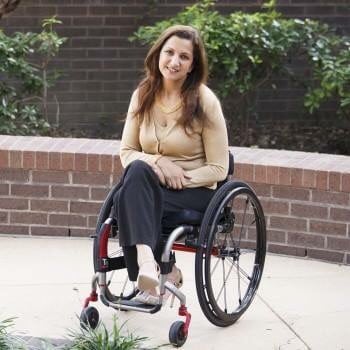After a spinal cord injury (SCI), it’s understandably easy to let proper self-care habits like a proper diet and exercise regimen fall by the wayside. However, it can be just as easy to start taking control of your health again. Here are my top 5 tips for improving and maintaining health after a spinal cord injury.

1. Exercise regularly.
During recovery after a spinal cord injury, people stay at a rehabilitation hospital where they receive physical and occupational therapy. The rehab staff knows which exercises and equipment will work best for your level of injury, and they often suggest an exercise regimen to continue when you return home. This is the first step toward maintaining your physical health after your SCI.
Exercising after a spinal cord injury isn’t just about staying in shape. Improved breathing ability, blood circulation, and immune system function are potential benefits.
Here are a few suggestions for exercising with a spinal cord injury:
Contact a local physical therapist or outpatient physical therapy clinic. They can tailor an exercise program or recommend home exercise equipment to fit your level of injury. In addition, some therapy facilities offer their own accessible gym for a monthly fee. First, they may require a written order from your doctor.
Consider a local gym with an experienced fitness instructor who can work with you one-on-one.
The internet has a wealth of information about cheap and easy workout routines for people with spinal cord injuries, including quadriplegics. Many of the routines are easy to perform alone or with an assisting partner.
Additionally, you might consider adaptive yoga for its many benefits.
2. Consume a healthy diet.
The foods and beverages we choose may have the power to nourish or harm our bodies. It’s important to think about your diet when it comes to maintaining health after a spinal cord injury.
After my spinal cord injury, I had a goal to stay strong enough to handle daily tasks easily. Therefore, I try to consume enough protein for my body to help maintain or build muscle tissue. Also, fiber is a good idea to aid in bowel function. Plus, you should get all the recommended vitamins and minerals your body needs to prevent illness and have energy.
Personally, I like to include plenty of fruits, vegetables, and grass-fed meats in my diet, and I enjoy making juices and smoothies at home. My favorite smoothie, which is easy to make in a blender at home, is composed of dark leafy green vegetables that are rich in antioxidants and vitamins, an apple for fiber, and a dollop of probiotic yogurt, which replenishes good bacteria in your gut.
The first step toward developing a healthy diet after an SCI may be to consult with your prescribing doctor or a licensed nutritionist. They can help determine what foods and nutrients will best suit your individual needs.
3. Make regular check-ups and annual vaccinations a priority.
Speaking of the doctor, it’s a good idea to stay proactive about maintaining your health after your SCI by making regular doctor appointments. I prefer to see my general practitioner at least once a year, as well as my specialist doctors.
Plus, I get an annual flu vaccine and the pneumococcal and shingles vaccines, as these are both directly related to my condition. This may reduce the chances of coming down with flu or pneumonia, which can be particularly hard on people with spinal cord injuries.
4. Reach out for support.
When it comes to maintaining health after a spinal cord injury, mental health is important too. After a spinal cord injury, it’s normal to go through stages of grief. However, it’s a good idea to be proactive about your mental and emotional state by getting support or even going to a counselor or talk therapist.
Depending on your health insurance benefits, you may be able to start seeing a psychologist or licensed counselor at little to no cost. In addition, you can also find free support through online or local spinal cord injury support groups. Peer support can help you better adjust to life after an SCI. Plus, it’s a great way to make friends who know what living with a spinal cord injury is like.
Online talk therapy is becoming more widespread these days, which can be especially helpful for people who have trouble getting around or have no in-person therapy options locally. For example, options like Talkspace are popular because you can get talk therapy all through a text messaging platform on your phone.
Better Help is another helpful online therapy option through live chat, phone, or video sessions with verified counselors. Through a series of questions, they match you to a counselor who may be right for you, and they have reasonable rates.
5. Use the right medical supplies for your needs.
Lastly, using the right medical supplies for your individual needs is a good idea, including incontinence products or intermittent catheter supplies. For instance, did you know that people with a spinal cord injury may have an increased risk of urinary tract infections (UTIs)?
180 Medical founder Todd Brown dealt with recurrent UTIs after his spinal cord injury, too. These infections dragged down his overall health and left him feeling worn out constantly. Fortunately, some friends in the wheelchair racing circuit introduced him to closed system catheters. With this advanced catheter product, Todd’s health began to improve. He felt it truly turned his life around. Ultimately, this led to the creation of 180 Medical. Todd wanted to turn other people’s lives around through a company with friendly top-notch customer service and high-quality products.
I know firsthand that adjusting to life after a spinal cord injury can be a long process. However, just by seeking out information about how to improve your health after an SCI, you’re definitely on your way.